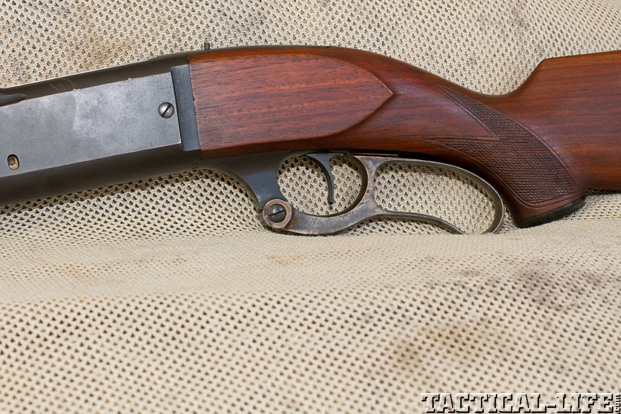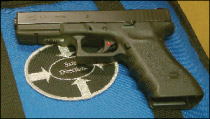The term “innovation” is one of the more misconstrued words in our vocabulary. Something that is truly innovative represents a new method or technology and the manufacturers of all sorts of products want consumers to think their products are right on the cutting edge. This is especially true in the firearms industry, where new products are heavily promoted. Some of these products might be solid performers, but categorizing them as an innovation is typically a great deal of Madison Avenue hype.
However, a centerfire rifle that clearly met the description was the Savage Model 99. Not only did the M99 enjoy a long production run, it was a true innovation that was light years beyond the other lever actions of the day. In fact, it would be more than a half a century before Savage’s competitors could field anything that could compete head-to-head with it.
Shooters are drawn to lever actions for all sorts of reasons. This southpaw has long preferred lever actions over bolt guns, which are typically all wrong from my perspective. Lever actions are ambidextrous and work equally well from either shoulder. I am especially fond of old, classic designs and it was inevitable that I became acquainted with the Savage M99. To date, my experience has been very positive and the accolades it has achieved over the years are right on the money.
Advertisement — Continue Reading Below
M99 Lineage
During the last years of the 19th Century, there were more advancements in the evolution of firearms than any time in the past. Reliable double-action revolvers, semi-automatic pistols and machine guns all arrived on the scene. Smokeless powder was developed and the armies of the world were replacing their muskets with modern repeating rifles that fired high-velocity ammunition.
This change in direction was not lost on Arthur Savage, and in 1893, he patented a lever-action rifle that went into production as the Model 1895. The Savage designed M1895 was very different from the Marlin and Winchester lever actions in that it was a hammerless design and utilized a rotary rather than tubular magazine. Savage had hoped to market this rifle to the military, but inevitably the U.S. Army went with the Krag-Jorgensen rifle.
Advertisement — Continue Reading Below
Shortly thereafter, a few improvements were made to the original design and the improved version was known as the Model 1899 (later shortened to Model 99). Obviously, the M1899 was a bit sleeker than other popular lever guns, but that was only part of the picture.
If I had to identify a single quality that set the Savage M99 apart from the other lever actions of the day, it would have to be the unique rotary magazine. This magazine used a spring-loaded, rotating spool, which allowed for the use of pointed spitzer bullets for better performance at extended distance. The Marlin and Winchester design featured tubular magazines where reserve ammunition was arrayed in a line. In a tubular magazine, spitzer bullets could come in contact with the primer of the cartridge in front of it and cause a catastrophic accident. Consequently, tubular magazine guns are limited to flat or round nose bullets, which limits their downrange performance.
Other novel features of the M99 included a counter that tells the shooter how many rounds are left in the magazine. A cocking indicator protrudes from the top of the receiver and the user can instantly ascertain condition by feel.
Advertisement — Continue Reading Below
Most experts would consider the Savage M99 action stronger than other lever guns of the day. Breech closure was accomplished with a block that was thrust forward and up to lock in the mortises cut into the receiver. In later years, the Savage M99 was chambered for high-performance cartridges such as the .22-250 Remington, .284 Winchester and .308 Winchester, none of which can be categorized as weak reeds. Instead of an external hammer, the M99 used an internal striker, which yields a faster lock time with better accuracy potential under field conditions.
The M99 enjoyed a very long run and was in production until 1997. Ultimately, it became too costly to produce and its passing is much lamented. Over the years, a mind-boggling number of M99s were produced in a wide array of calibers, barrel lengths, and stock configurations. Late production examples were also available with detachable box magazines. While it might be argued that the M99 has been eclipsed by more modern designs, it was in a league of its own for many years.
Savage Cartridges
Advertisement — Continue Reading Below
Like most successful rifle designs, the Savage M99 was chambered for a wide variety of popular cartridges during its extended run. Early Savage rifles were chambered for proprietary cartridges, but over time other popular chamberings were included in the line. Both the original M1895 and M1899 were chambered for the .303 Savage. Despite its name, the .303 Savage is a true .30 caliber and uses standard .308 diameter bullets. Although relatively tame by modern standards, the .303 Savage was developed as a potential military cartridge and performance was on par with the .30-30 Winchester. A load with a 190-grain bullet was offered and many hunters felt it offered a tangible advantage over the popular .30-30 Winchester. Factory ammo has been out of print for years and today the .303 Savage is strictly a roll-your-own proposition.
Savage’s next entry, the .22 Savage High Power, set the stage for better things to come. Designed in 1912 by Charles Newton, the .22 High Power is essentially a .25-35 Winchester case necked down to accept a 70-grain .228 diameter bullet. In the M99, accuracy was mediocre and by the l930s, this round was rendered obsolete by better performers.
Unlike the .22 Savage High Power, Newton’s next contribution to the Savage line proved to be a real success. The .250 Savage (.250-3000) was the first commercial cartridge to break the 3,000 fps barrier. It continues to fill a niche to this day where it strikes an ideal balance between light recoil and sufficient power to clearly take deer-size game.
Advertisement — Continue Reading Below
The final entry proved to be the most popular of the Savage offerings. In 1920, the .300 Savage arrived on the scene and boosted external ballistics approaching that of the highly regarded .30-06. This cartridge proved popular not only in the M99, but in bolt-action and semi-auto designs as well. Its popularity was largely due to the fact that it could be chambered in medium length actions, yet offered enough power to take all North American animals, with the exception of the large bears. Thirty years later, the .300 Savage served as the inspiration for the .308 Winchester, which today fills that same role.
In addition to the Savage cartridges, the M99 was available in .30-30 Winchester and .38-55 Winchester. Later on, guns were chambered for the .22-250 Remington, .243 Winchester, .284 Winchester, .308 Winchester, and .358 Winchester.
My M99G Takedown
Advertisement — Continue Reading Below
A few years back, I lucked into a most interesting Savage M99. Chambered for the .303 Savage, my M99G is over 80 years old and while not showroom new, is still a very solid machine. It features a lightweight 20-inch barrel, pistol grip stock with checkering and schnable forend, and a steel shotgun buttplate. Sights consist of a buckhorn rear adjustable for windage and a front blade pinned to a raised base. A sliding catch on the sight side of the case-hardened lever serves as a safety. In the forward position, the safety locks the lever and prevents rearward movement of the trigger.
The forearm of my M99G is easily removed by sliding a spring-loaded latch to the rear and pulling it down and off the barrel. The M99G is a takedown rifle and interrupted threads hold the barrel to the receiver. A one-third clockwise turn will separate the barrel from the receiver, which is a plus for both cleaning and storage.
Ammunition in .303 Savage is extremely hard to come by, so I have to craft my own. I was fortunate to pick up several boxes of virgin brass and a set of RCBS reloading dies, along with the rifle, to accomplish this. My pet load consists of a Speer 170-grain Hot-Core bullet and a dose of IMR 4320 powder, which yields about 1,800 fps and change. This is hardly a maximum load, but hits steel plates with authority and will group inside of 2 inches at 50 yards. If I need a little more juice, I simply reach for its younger cousin.
Advertisement — Continue Reading Below
In addition to the M99G takedown, I am also the proud owner of a newer Savage levergun chambered for the .308 Winchester. Crafted in the 1960’s, this rifle wears a period-correct Bushnell 4X scope and accuracy wise, can hold its own with most hunting-grade bolt actions.
From a sandbag rest, I was recently able to fire a three-shot group with Black Hills match ammo that measured a scant .75 inches across. If I do my part with this rifle, I can print groups well under 2 inches all day long.
A True Classic
Advertisement — Continue Reading Below
Despite the fact that the Savage M99 has passed from the scene, that in no way diminishes its importance in the evolution of the sporting rifle. I daresay it easily ranks in the top 10 of American sporting arms and tens of thousands of M99s are still regularly used to bring home the venison.
The M99 did indeed blaze new territory and deliver a whole new level of performances not possible with other lever actions. Unlike early 20th Century bolt actions, it was sleek and fast into action and equally handy as “old school” lever guns. This is especially true of lightweight guns such as my old M99G.
If you’ve got an M99, count your lucky stars and go out and shoot it. With a little TLC, these American classics will continue to deliver the goods. For more information on Savage Arms, visit savagearms.com or call 413-642-4260.





































